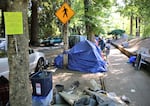
126 people who were living on the streets of Multnomah County died last year, the most since officials started tracking the data in 2011.
Kristian Foden-Vencil / OPB
At least 126 people who were living on the streets of Multnomah County died in 2020. That’s the highest number since officials started tracking the data back in 2011.
The deaths were all investigated by a medical examiner, as they were either deemed suspicious or happened outside a hospital or other health care setting.
One striking figure in the annual report: methamphetamine contributed to 62 deaths. That’s almost 80% of all deaths that involved substance use, “...far outstripping things like opioids, heroin, alcohol and fentanyl,” said Multnomah County’s health officer, Dr. Jennifer Vines.
The meth figure is the highest percent reported since the Domicile Unknown study started.
The Domicile Unknown 2020 report, put together by Multnomah County and the alternative newspaper Street Roots, included the story of a 26-year-old man, Christopher Madsen-Yamasaki, who overdosed on methamphetamines in a tent tucked under an Interstate 405 overpass. His mother, Hope Yamasaki, said Christopher was trapped between an addiction for which no medication could ease his craving, and a mental illness that kept recovery out of reach.
“He would be asked to leave addiction centers because they can’t treat mental health. And he would be asked to leave the mental health hospital because they can’t treat addiction issues,” Hope Yamasaki said.
She said sometimes her son would beg to get into treatment.
“Help is not as easy to get as many people think,” she said. “There’s just not enough resources available.”

26-year-old Christopher Madson-Yamasaki died in his tent of a meth overdose. He's just one of 126 people who died while experiencing homelessness in Multnomah County last year.
Multnomah County
Related: Domicile Unknown: Multnomah County's report on deaths among people experiencing homelessness in 2020
Another surprising fact included in the report was that none of the reported deaths were caused by COVID-19.
Multnomah County Chair Deborah Kafoury said that might be because the county responded quickly to the pandemic. “Adding temporary shelter sites allowed us to maintain the number of shelter beds while practicing physical distancing,” she said.
Kafoury said the quick shift to providing individual rooms in physical distancing motel shelters and voluntary isolation motels also helped.
“I’m grateful that these decisive actions helped us avert the surge of COVID-19 deaths that we feared was possible among those who were living outside,” she said.
Still, a report released Wednesday on these deaths said some COVID-19 cases may have been missed as people hospitalized for at least 24 hours prior to death would not have been included.
Dr. Jennifer Vines said the Domicile Unknown 2020 report lists many different causes for death. Half the cases were deemed accidental deaths, and about a third were from natural causes. Eight of the 126 deaths tracked were homicides, and six of those involved the use of a firearm — the highest percentage in three years. That tracks with an overall increase in gun violence in 2020 in Portland.
Related: With Measure 110, Oregon becomes 1st state in the US to decriminalize drug possession
While the number of deaths among the unhoused hit a record high in 2020, the number of people who are homeless has also increased over the last decade.
The average age of people who died on the streets was 46, “which is incredibly young,” Vines said. The average life expectancy for Americans is 78.
Men represented about 80% of the deaths counted in the report. The percentage of Black people and people of Native Alaskan or American Indian descent who died while homeless last year outpaced the actual demographics of Multnomah County.
Fewer people living on the street took their own lives in 2020. There were four deaths by suicide — representing 3% of all deaths reported — the lowest number recorded since the county and service providers began tracking homeless deaths a decade ago.
The likelihood that a person would die while homeless didn’t appear to change in colder weather: About 52% of the deaths were reported in the warmer months.
